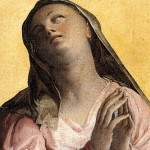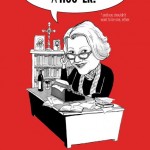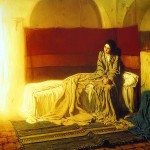At the cross, her station keeping
+ + + + + +
Mary’s role in the life of the church, in the Christian experience did not end with the deliverance of her placenta and the taking of her ritual bath. Rather, Mary – The Mother – walked with and monitored every part of her son’s life (as mothers do) and his ministry. Far from being a toss-off, a mere minor player in the story of Christ and the Christian experience, Mary’s life is as entwined with Christ’s at his death as it was when he was living and growing inside her body. Her life is entwined in the whole of the story of Salvation.
She was there when Christ was found, talking with great wisdom with the elders; she raised an eyebrow at him and we can imagine the mixture of relief and fear when she found him: “your father and I have been worried sick, now you get over here and don’t take off on your own like that again!”
She was there at Cana, tugging at his sleeve and saying, “hey, these people have a need, please help them…” and to the waiters, “do as he tells you…”
She was there as he preached, and as he was arrested and tortured, and as he carried his cross. She was there –- not running away –- broken, yet completely faithful, as he died before her eyes, after telling her that her work was only just beginning, that she had no time for a luxury of grief, because now she was to be The Mother to others, even as he told John that he (and we) were to hold her to that role.
She was there as the apostles hid in the upper room. Likely she was around the food, making everyone as comfortable as possible and raising the eyebrow again, wondering if these men would ever “get it.”
And she was there at Pentecost, when the Holy Spirit came down and the church was formed.
We don’t read about Mary in a “leadership” role in the Acts of the Apostles, but I suspect that this is because Mary’s leadership was lived in the guise of The Mother.
The guidance (and the role of overseer) which is part and parcel of a mother’s job is –- while indispensable –- rarely understood as “leadership.” This is as true today, in our “enlightened age” as it was in the “patriarchal” Judean culture. The attention to detail, the fussy “human” stuff, the work, wisdom, planning and supervisory/administrative role of a mother is as under-appreciated now as it was, then, but in either era it is the backbone of . . .well, if you really stop to consider, the role of The Mother is the backbone of everything that is and was and will be.
Luke does not write about Mary in the Acts, but it is not unthinkable that as the apostles were building up the church Mary was doing more than simply feeding people and washing clothes. I am sure she did do those things, but she was a mother –- The Mother of the church –- and so I am quite certain that aside from her domestic tasks Mary was pointing the apostles and those first followers in this direction and that saying, “make sure you talk to so-and-so,” “don’t forget about thus and such,” “did you remember to do this or that?” “I overheard thus-and-such, you’d better be aware of that, and make sure you . . .”
That’s the affectionate watchfulness of The Mother, too often seen by her children as nagging, and it might have seemed like nagging to the apostles, too. But all of that meddling and observing and commenting has a tendency to beget planning and strategy and the foreseeing-and-overcoming of obstacles before they muck things up.
This is what mothers do. It is what I suspect Mary did, constantly at the service of the church, at the service of the apostles and the believers, serving them not only with her hands but with the wisdom of The Mother, gleaned over a lifetime of work and love.
Having given her own flesh and blood to the Incarnate Word who knew Christ better than she? Who could explain to his sometimes thick-headed apostles what he was about, how the woman who bested him in reason, (“but even the dogs eat the crumbs that fall from their masters’ table.“) probably pleased Jesus with her cleverness, not only because it demonstrated her faith, but because it nudged his good humor.
Perhaps she cued Luke (who tradition holds interviewed Mary, personally) into the fact that when Jesus said, regarding Herod, “Go tell that fox that I cast out demons and heal the sick…” he was not merely giving forth information, but he was having fun with language, as well, by calling Herod a “fox,” which was another way of calling him (scripturally) a weakling, that he was a small, scuttling opportunist whom Christ did not fear, and whom we should not fear, either.
Mary said “yes” to the Angel of the Lord. She was the Ark of the New Covenant, there at the beginning of the great pageant of Salvation.
She is here, now, the approachable Mother to whom countless parents and children turn when –- exasperated or undone by human relations –- they need a wise mother in whom to confide. But her answer is always the same, “Do whatever HE tells you . . .”
She is in the time to come –- Revelation 12 calls her “the woman clothed with the sun, with the moon under her feet,” the very image which, after 500 years, still shows itself on the rough, plant-fibered tilma of Juan Diego — the image of reassurance.
But that is what a mother does. She reassures. She works for her family. She serves. She carries on and carries forward, doing the things that need to be done. Even if all the while, her heart is pierced with a sword of deep and lasting sorrow.
And we, who each carry within our own lives wounds both secret and open, have in this Sorrowful but Eternal Mother, a perfect confidante, a Mother to whom we can turn because we know she’s “been there, done that.” When a daughter keeps dubious company and a son gets himself in trouble, you can turn to Mary and say, “Mary . . . what am I to do with this child? Help!”
“Do,” she will counsel, over and over, “what He tells you . . .”
Related:
A Via Dolorosa Not to be Missed











